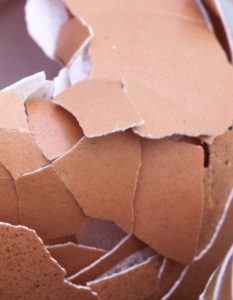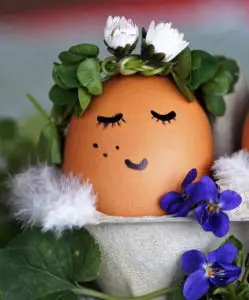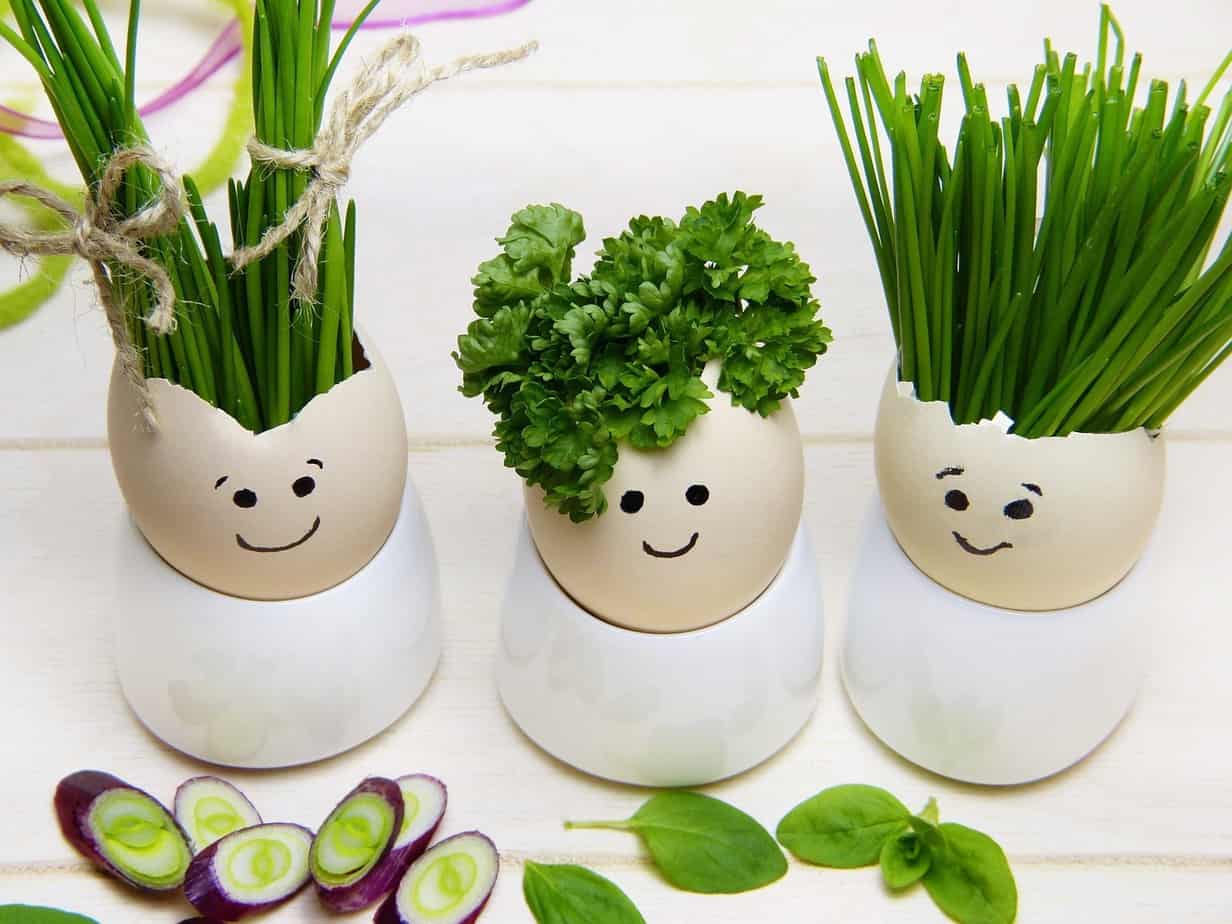Some links in the post are affiliate links and I get a commission from purchases made through some links found in the post.
Eggshells? You must be wondering what do eggshells have to do with plants?! I mean, you throw them after using the egg white or the egg yolk or perhaps both, right?
But let me tell you, eggshells in potted plants have some AMAZING benefits for your plants.
They will improve your plants’ quality and be used in many ways, which you never considered before making that breakfast!
As a quick guide, to use eggshells in your potted plants you need wash the eggshells carefully and let them dry till the next day and then finely crush them. Then sprinkle them over the surface of your potted plant.
The eggshells will provide a variety of nutrients for your plant including calcium, magnesium, phosphorus, potassium and sodium as well as helping to maintain the chemical balance of the soil.
Keep reading to know more about how to use eggshells in your potted plants for a better and healthier plant for your house, whether indoor or outdoor!
Why Should You Use Eggshells in Potted Plants
Eggshells contain a variety of nutrients which will prove to be beneficial for your potted plants. An eggshell has 94 percent calcium.
This helps the plants in maintaining the chemical balance of the soil. The eggshells also help in reducing the salinity of the soil.
Eggshells also contain magnesium, phosphorus, potassium, sodium, and also some water. How great is that?
The inner skin consists of the most nutrients, and this organic matter is the most beneficial for the plants after it decomposes.
How to Use Eggshells as a Fertilizer in Potted Plants
So one of the most affordable eggshells is obviously chicken eggshells since it is one of those items which are lying in your fridge all day, every day!
However, if you are not an egg lover but a lover of plants, you might start saving some eggs!
Preparation of Chicken Eggshells as a Fertilizer
Firstly wash the eggshells carefully and let them dry till the next day. Since eggshells are pretty hard and sharp, make sure to use all the tools available at your house to grind them.
Using raw eggshells is preferred, so make sure you don’t use an eggshell of a boiled egg.
After cracking that egg, leave the eggshell in a spacious area where it gets airdries, which might take 3 to 5 days, after which you can store it in a paper bag.
How to Create the Compost
- The foremost thing you need to do is grind those eggshells and mix water in it.
- Leave it for three days, then mix the solution.
- Now water the plants under the roots.
Another way to use Eggshells:
- Lay the dried eggshells at the bottom of the plant.
- Try crushing them to get a 3cm layer.
- This will prevent the water from stagnating in the soil.
Now that you know how to make fertilizers from eggshells let’s look at some more benefits of eggshells, whether for your plants or any other way you want to use eggshells.
Eggshells in Potted Plants: Seed Starters
Eggshells can also be used as a seed starter. Just save the larger part of the eggshell and sterilize them by baking them at 200F for about 30 minutes.
Now make a hole at the bottom of your eggshells for drainage and place the soils and seeds in it. When you see it sprouting, plant the plant with the eggshell into the soil.
In case you are wondering how to plant succulent babies in eggshells, then keep reading our step-by-step guide making it easier for you to plant those babies in an eggshell!
Eggshells in Potted Plants: Materials
Eggs(obviously)
Small succulents
Succulent soil
A spoon and a needle
Eggshells in Potted Plants: How to Plant
1) Break the egg slightly, just enough for the egg to drain out.
2) Clean the eggshells as described earlier in the post. Also, make sure to create some holes at the bottom of the eggshells if you want to move the plant to a bigger pot. This allows the roots to grow without getting stuck.
3) Keep the eggs in an egg container, so that it doesn’t topple over and now add the soil.
4) The last step is to create a deep area in the soil and place your succulent gently.
5) Then gently pat the soil around it and add more soil if needed.
If you are thinking about watering the eggshell planters, let me tell you, be extra careful not to overwater the succulents.
Check the soil by touching it and if it feels dry, only then sprinkle some water and provide them with bright light for them to thrive!
Eggshells in Potted Plants: Pest Control
A coating or crushed eggshells will keep the animals away!
Whether large or small. In case you are worried about some animals or pests attacking your plants, don’t worry!
Just sprinkle some crushed eggshells on the soil, and you are safe from that pest attack!
Eggshells and Compost pile:
If you add eggshells to your compost pile, it will decompose with the rest and enrich it.
Crush the eggshells with the help of a blender into smaller pieces for faster decomposition.
Eggshells and Birds:
Eggshells make an excellent way to feed the birds. The extra calcium in the eggshells is also a great food for the birds, especially females about to lay eggs or have just laid eggs.
After using the eggs, make sure to sterilize the eggshells and leave them to cool down.
After this, crush the eggshells and mix them into your bird seeds for a great nutrition source for the birds!
Effective Mulch in the Garden:
Crushing eggshells work just like any commercial mulch you’ll find in the market.
After crushing the eggshells, lay them on top of the garden soil. The white texture will give the garden an amazing garden bed!
Eggshells for Drainage Holes
Since eggshells are rich in calcium, they can also cover the drainage holes of your plants. Add a thick layer of large crushed eggshells onto the bottom of your plant.
Then it would help if you broke the eggshells; they should be large enough to cover the drainage holes. Lastly, cover the holes loosely to prevent the soil from falling out.
Eggshell Tea and Its Benefits!
 As we all know, eggshells are full of calcium, which is the main ingredient for your plants’ growth. But when it comes to watering those plants, we stick to the plain old water, right?
As we all know, eggshells are full of calcium, which is the main ingredient for your plants’ growth. But when it comes to watering those plants, we stick to the plain old water, right?
What if I told you you could make organic calcium tea using the ingredients readily available at home?
Yes, that’s eggshell tea! Keep reading to know the step by step guide on how to make that eggshell tea.
- Clean your eggshells.
- Crush them until they are broken into small pieces.
- Now put them in boiling water.
- Leave it overnight.
- The next day strain the eggshells from the water, and you will be left with just water.
Water your plants with this amazing tea and see a boost in the growth of your plants!
Now you have eggshell organic tea that is super easy to make and will also help your plants perk! You will see a difference in no time when you use this tea.
If you’re enjoying this article, check out our article on how to landscape with potted plants.
Other Uses of Eggshells
Your garden is not the only place where you can use your leftover eggshells.
There are lots of other ways to use the eggshells after you have eaten the egg! Check out some of the ideas below!
1) An eggshell cleanser for your house:
Mixing ground eggshells with soapy water will help create a non-toxic household cleaner for those dirty dishes.
2) Booster for Dogs:
After drying your eggshells in the oven, crush them to make a fine powder out of it. Adding this powder to your dog’s food will improve its canines and bones and give it a calcium boost.
3) Facial Treatment:
Pulverize the dry eggshells with some mortar and pestle and then mix them with some egg whites to create a healing facemask!
Rub it on your face and allow it to cool before washing, and find your skin fresh and renewed with this simple and easy face mask!
4) Treatment for Blemishes:
If you have a rash or any other minor blemishes, then eggshell to the rescue!
Just soak a piece of an eggshell in vinegar for two to three days and then take the shell out.
Whenever you face any minor rash or blemish, apply this eggshell to those to get rid of them in no time!
5) Drain Cleaner:
If you have a clogged kitchen sink, then don’t worry! Eggshell can also be used as a drain cleaner.
The bigger pieces of eggshells will trap any solids to help the water flow easily, and the small pieces will clean the pipe and make your life easy!
Quail Eggshells in Potted Plants and its Benefits:
Although chicken eggshells are preferred since its easily available, Quail eggshells also make great fertilizer for your plants.
Quail eggshells contain 95% more calcium, which is slightly more than chicken eggshells.
How to make Quail eggshell fertilizer:
- You will need around 50 crushed quail eggshells.
- Pour some acidified water in it. This helps to free the calcium from the eggshells.
- Keep them for three days.
- Water your houseplants under the roots.
Natural Fertilizers Other than Eggshells
If you are a plant lover or someone beginning to take up this hobby, then go no further than your own pantry or backyard to make natural fertilizers for your potted plants.
You don’t really have to spend a lot of money on your plants as people think nowadays.
Back in the day, people used natural fertilizers easily available to them. This is a far better and cheaper way of having healthy plants.
1) Banana Peels:
Yes, you read that, right! Banana peels are a rich potassium source containing a small amount of nitrogen, phosphorus, and magnesium.
You can use banana peels either by directly putting them on to the soil and covering it with a little soil to avoid its smell, or you can also peel it into small pieces and mix it in the soil or blend the banana peels with mater to make a liquid fertilizer for your plants.
2) Boiled Water:
The water you use to boil vegetables can also be a great source of nutrition for your plants.
After you are done boiling your vegetables, allow it to cool down before giving it to your houseplants.
3) Green Tea:
If you’re a green tea lover, then this is good news for you! After drinking the green tea, save the tea bags to create easy houseplant food.
Empty the tea bag and put the leaves directly onto the soil or mix the leaves with boiled water to create a liquid fertilizer for your plants.
Use green tea on acidic soil as it makes the soil more acidic.
4) Coffee:
Mix a scoop of coffee grounds before planting or mix the coffee with water and use that water on the plants.
Coffee makes the soil more acidic, so it will be best to use it on acidic soil.
5) Hair:
A handful of your own or kids’ hair is a perfect fertilizer for your plants. The good news is that this is always available at your house.
Just take that hair and put it on top of the soil. This gives some amazing nutrients to your plants and enhances their growth!
6) Epsom Salt:
Epsom salt contains minerals that boost plant growth. You can make a liquid fertilizer by mixing and liter of water and a teaspoon of Epsom salt.
Just pour this mixture on top of your plants and see the magic unfold!
7) Aquarium water:
Water your plants with your fish tank water. You can take some water while cleaning it and it should be freshwater without salt. The fish water is a great fertilizer for potted plants.
However, if you choose between quail and chicken eggshells, chicken eggshells are a better option. Since chickens’ diet is more diverse hence the eggs produced are also of better quality.
Fertilizers made out of both eggshells are a great way to boost your plant growth. The eggshells help maintain the pH level in the soil and hence have a very positive effect on the plants’ development.
If you enjoyed this article, check out how to start growing carrots from scraps.
Final Thoughts: How to Use Eggshells in your Potted Plants?
 So this was all about eggshells and its benefits in your potted plants.
So this was all about eggshells and its benefits in your potted plants.
I hope this post gave you the boost you needed so badly to get started with gardening.
If you’re already a gardening enthusiast, then I hope these simple tricks and tips were beneficial for you and your plants! Happy Gardening!


